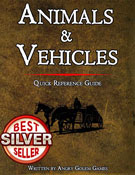Large beast (animal), unaligned
Armor Class 13 (Natural Armor)
Hit Points 42 (5d10+15)
Speed 50 ft.
Proficiency Bonus +2
Proficiency Bonus +3 (5th Edition Advanced Mode)
| STR | DEX | CON | INT | WIS | CHA |
|---|---|---|---|---|---|
| 19 (+4) | 10 (+0) | 16 (+3) | 2 (-4) | 11 (+0) | 6 (-2) |
Skills Perception +2
Senses passive Perception 12
Challenge 2 (200 XP)
Beast of Burden. The buffalo is considered to be a Huge animal for the purpose of determining its carrying capacity.
Poor Sight. Buffalos have disadvantage on perception checks based on sight.
Trampling Charge. If the buffalo moves at least 30 feet straight toward a creature and then hits it with a gore attack on the same turn, that target must succeed on a DC 14 Strength saving throw or be knocked prone. If the target is prone, the buffalo can make one attack with its gore against it as a bonus action.
ACTIONS
- Multiattack. The buffalo makes two attacks with its gore.
- Gore. Melee Weapon Attack: +6 to hit, reach 5 ft., one target. Hit: 8 (1d6 + 5) piercing damage.
DESCRIPTION
The buffalo is a large, herbivorous mammal that resembles a shaggy-haired ox. It has a massive head, curved horns, and a humped back. Its fur is usually brown or black, but can also be white or spotted. Buffaloes are social animals that live in herds of varying sizes. They are native to grasslands and plains, but can also adapt to other environments.
COMBAT
Buffaloes are not aggressive by nature, but they will defend themselves and their herd if threatened. They can charge at enemies with their horns, trample them with their hooves, or gore them with their tusks. Buffaloes are also very resilient and can endure harsh weather and injuries. They have a keen sense of smell and hearing, but poor eyesight.
HABITAT / SOCIETY
Buffalos prefer open areas with abundant vegetation and water sources. They migrate seasonally to follow the food supply and avoid predators. Buffaloes form complex social structures based on age, gender, and rank. They communicate with each other using grunts, snorts, and bellows. Buffaloes have a symbiotic relationship with some birds, such as oxpeckers and egrets, that feed on the parasites on their skin and warn them of danger.
ECOLOGY
Buffaloes play an important role in the ecosystem as grazers and prey animals. They help maintain the balance of the vegetation by eating grasses and shrubs. They also provide food and resources for many other creatures, such as lions, wolves, hyenas, vultures, humans, and more. Buffaloes are revered by some cultures as symbols of strength, fertility, and abundance.
Buffalos can be used as mounts or pulling animals for vehicles.
The statistics are detailed in the D&D 5e Animals & Vehicles reference guide.
Just have a look at the preview on DrivethruRpg.
